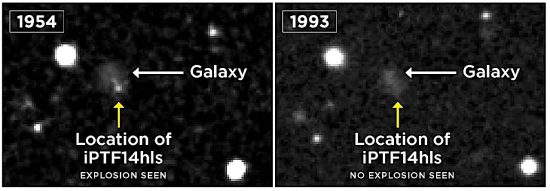
Supernova iPTF14hls. Credit: Adapted from Arcavi et al. 2017, Nature. POSS/DSS/LCO/S. Wilkinson.
Oct 25, 2018
Stars are electrical entities.
The explosion of a star, otherwise known as a supernova, is a terminal event in stellar evolution—the star used up its fuel, collapsed under its own gravity, and then ejected most of its gaseous envelope because of “core rebound”. At least, that is how astronomers think stars with certain characteristics should behave.
According to a recent press release, iPTF14hls seemed identical to a familiar class of supernova. Until it dimmed and then brightened again. In fact, it did the same thing several times. Lead researcher Iair Arcavi from the University of California Santa Barbara and Las Cumbres Observatory said:
“This supernova breaks everything we thought we knew about how they work. It’s the biggest puzzle I’ve encountered in almost a decade of studying stellar explosions.”
Many previous Picture of the Day articles point out that stars are not simplistic balls of gravitationally compressed hot gas, they are composed of plasmas. Plasma is ionized, meaning that one or more electrons are stripped from its atoms, so it is electrically charged. Plasma does not behave like a pressurized gas, it behaves according to the tenets of plasma physics.
Electricity flowing through plasma forms regions called double layers: the “charge separation” so often mentioned in these pages. Could charge separation be the foundation for the electrical explosions known as supernovae?
A supernova is an “exploding star.” However, that explosion is due to the breakdown of double layers, and not core collapse and rebound. Since the stars are externally fueled currents of electric charge flowing through circuits in space, supernovae are the result of a stellar “circuit breaker”. When a star’s double layers explode, electromagnetic energy from a vast galactic circuit flows into the explosion. The resulting supernova radiation is emitted across the entire electromagnetic spectrum from radio to gamma rays.
Electric Universe advocate Wal Thornhill wrote:
“Stars are an electrical plasma discharge phenomenon…The energy is transferred over cosmic distances via Birkeland current transmission lines. The energy may be released gradually or stored in a stellar circuit and unleashed catastrophically. It is these cosmic circuits that are the energy source for the supernova explosion – not the star.”
Since stars are the foci for enormous energies from the galaxies in which they exist, their activity cannot be based on mass, or a particular elemental makeup. They are not internally powered objects at all, they are formed electromagnetically in cosmic Birkeland currents. Stars are born of electricity, and electric stars are where the seeds of supernovae mature. Therefore, iPTF14hls is acting like an electrical oscillator, responding to incoming electric charge, and not like a gravitationally compressed ball of hot gas.
Stephen Smith
Hat tip to Christopher Phillips












